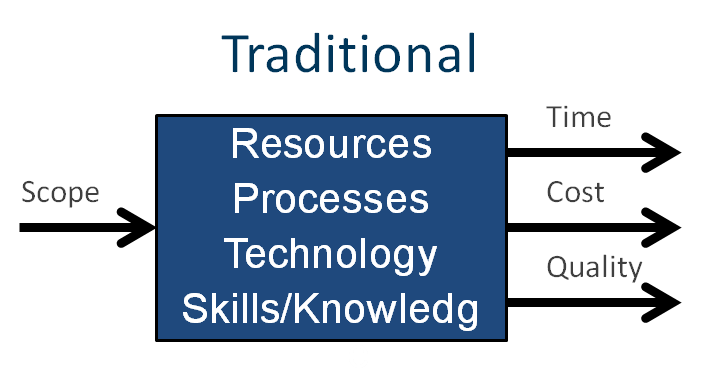Everyone in the project management profession has talked about this concept. The triple constraint is probably the only term that has been exported outside of project management circles. It is surprising to confirm that PMBOK V, the new version just published by PMI, does not mention this holy grail of project management (three is a holy number anyway, right?), as it did before. It does talk about constraints, and it lists time, cost, quality, scope, risk and resources, but no magic three are highlighted by PMI.
What is even more surprising, for such an embedded concept in the brains of some many project managers, is that everyone talks about this, but there are many versions of what the “three amigos”, as I called them in my native Spanish, actually are. In previous versions of PMBOK, there was reference to the concept of the triple constraint, but no mention to what the three were. There are several versions on this, and some push it to four or six. The most common are:
- Time, Cost, Scope
- Time, Cost, Quality
- Time, Cost, Scope, Quality, Risk, Stakeholder Satisfaction
- Time, Cost, Scope, Quality, Risk, Resources
To me, the discussion is fundamental, as it defines the difference between the traditional up-front planning paradigm and the agile/iterative paradigm. In the traditional paradigm of up-front planning, we start with scope, as an independent variable, and then we create a plan to deliver that scope, which is based on the capability of our process: the resources we have, skills and knowledge, the methods we use, the technologies available, etc. Based on these capabilities, for a given scope, we calculate a schedule, cost and quality, which now become dependent variables, as presented in the diagram below.

Fig 1: Traditional up-front planning paradigm
It is important to note that resources, risks, issues and the like are tied to the capability of the process, so they do not belong in this discussion. The quest for the three finalists is between the input and the output, the independent and the dependent variables. The rest is fluff.
In the agile/iterative paradigm, it is the exact opposite: we start with fixed time, cost and quality, as the number of sprints, size of the team and agreement on quality is decided. Opposite to the previous diagram, now these become the independent variables, which are then put through the capability of the process (resources, skills, methods, etc.) to determine how much scope can be covered, now the dependent variable.

Fig 2: Agile/iterative paradigm
To me, this settles the discussion: the three constraints are time, cost and quality, for a given scope, and they can be either the dependent variables or independent variables, depending on whether you are in the traditional paradigm or in the agile/iterative paradigm. Finally, there is some practical application to this holy grail in project management.
Further to the discussion on what the triple constraints actually are, this discussion proves that the two paradigms in project management are not only different, but opposite. No wonder how difficult it is for stakeholders to adopt agile approaches, as you need to actually “re-wire” your brain to function.

